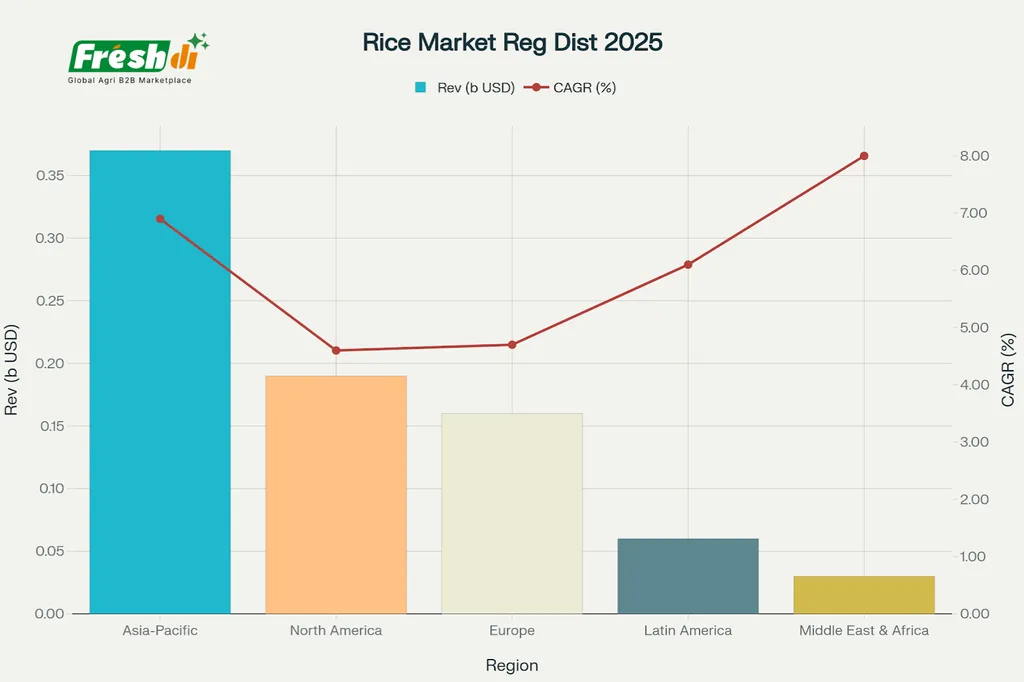Global rice prices have experienced a period of volatility, with recent declines followed by signs of recovery, creating a complex landscape for traders, producers, and investors. The International Grains Council (IGC) reported a 1% decline in its rice sub-Index over the previous month, attributed to slow activity and seasonal pressure. However, after reaching an eight-year low, international rice markets showed signs of recovery. This fluctuation underscores the importance of real-time data and market intelligence in the agricultural sector.
In Thailand, export quotations for 5% broken white rice gained $8 per metric ton (m/m), reaching $341 free on board (fob) Bangkok. This increase was driven by rain-related delays to the 2025-26 main season harvest and potential sales to China. Meanwhile, in India, white rice prices softened due to increased kharif crop arrivals, while parboiled values firmed up by $7 to $352 fob Kakinada, supported by tight spot supplies and enquiries from Bangladesh. Vietnam experienced dampened sentiment due to an extension of the Philippines’ import ban, while Pakistan saw firmer prices due to local demand.
The United States also witnessed significant price movements, with California medium-grain fob offers advancing by $58 to a 15-month peak of $869 (Oakland), driven by robust demand from Pacific Asia. The United Nations Food and Agriculture Organization (FAO) reported that October prices were 2.5% down from September and 21.7% below their October 2024 level. The most pronounced monthly fall was in glutinous quotations (5.9%), followed by Indica prices (3.0%) and Japonica and Aromatic quotations (0.5% each).
The FAO highlighted that Asian prices of Indica rice remained on a downtrend in October due to main-crop harvests and ample exportable supplies. Sentiment was weakest in Pakistan, where efforts to revive sales slashed prices to nine-year lows. The baht’s depreciation against the US dollar contributed to falls in Thailand, while in India, a slowdown in buying interest kept prices under pressure despite setbacks to harvesting activities. In Vietnam, the Philippines’ retreat from the market provided little room for quotations to regain ground, but cutbacks in Indica plantings and previously sealed deals prevented further price declines.
For agritech and investors, these market dynamics present both challenges and opportunities. The volatility in rice prices underscores the need for advanced analytics and real-time data to navigate the market effectively. Agritech companies can play a crucial role in providing these tools, enabling producers and traders to make informed decisions. Additionally, the reliance on speculation and the rumor mill, as highlighted by the US Rice Producers Association, emphasizes the importance of transparent and reliable market intelligence.
Investors should consider the potential for technological innovations in the agricultural sector to enhance productivity and efficiency, thereby mitigating some of the risks associated with price volatility. The confirmed sale to Iraq has ignited optimism in the US long grain sector, but the market remains cautious. With prices reported not to have exceeded $555 per metric ton (pmt) FOB New Orleans (NOLA), cash prices are not likely to reach levels that will excite producers to sell. This situation highlights the need for strategic investments in agritech solutions that can improve market access and pricing transparency.
In conclusion, the current state of the global rice market presents a mixed picture of challenges and opportunities. For agritech and investors, the key lies in leveraging technology and data to navigate the complexities of the market and capitalize on emerging trends. By doing so, they can contribute to a more resilient and efficient agricultural sector.

